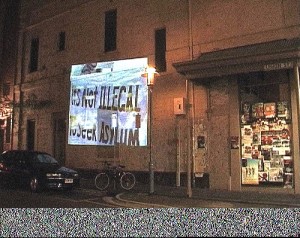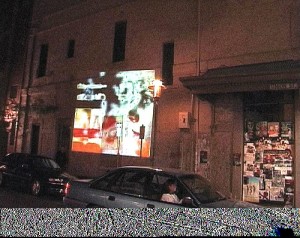Australia has a rich artistic history in mobile technologies using lo-fi and Do It Yourself (DYI) principles to produce everything from locative audio units, such as John Jacobs’ Wheelie Bin Sound System through to zero-ecological-footprint mobile entertainment units, such as the Lab Rats pioneering Wind Powered Cinema Caravan. As the focus on re-purposing existing and new technologies extends into artists pre-empting and prototyping not yet available technologies, it is interesting that some artists at the forefront of working with new technologies still espouse a preference for a lo-fi or simplest-technology-available approach to their work.
At a locative gaming workshop held by ANAT in 2004, Matt Adams from Blast Theory, an acclaimed UK collective working with interactive technologies, stressed the importance of the ‘simplest, most viable solution’ to any concept involving technology. In this way, artworks of this nature can essentially become prototypes for possible futures, rather than a finalised and fabricated work, which exists as an end point of its own. This ethos is clear in many Australian artists’ work that re-purposes technologies, and what is so interesting is that the very nature of lo-fi and DIY systems lend themselves to a practice of ongoing prototypes, of possible futures, and of transient experiences, which transform known environments.
The millennium was an interesting time to be living in Sydney. Olympics fever was running riot, the city was being spruced, non-photogenic sections of the population were being relocated and housing prices and rent were skyrocketing. Running parallel, and indeed partly in response to this strange time, were phenomena such as the Broadway Squats, which transformed a string of disused buildings in the city for housing, a free dumpster-derived café, gallery space and numerous other functions. This increase in reclamation and re-use (within a community already adept at DIY principles), coincided with a newfound affordability of technologies. This resulted in multiple projects of a mobile variety that capitalised upon the new, at the same time as encompassing simplest-solution technologies.
boat-people.org made papers across the nation in 2001 with a photo of Sydney Opera House sporting a large projected image protesting against the treatment of asylum seekers. This little mobile project was the result of a night time jaunt involving a small generator, a slide projector, a provocative image, some well-placed phone calls to the media and a short chat with Opera House security. boat-people.org have since gone on to do multiple campaigns and actions in Sydney and Melbourne, using similar simple, mobile projection techniques to project images onto public buildings or temporary structures, such as laundry on a line erected in Pitt Street mall, or simply onto people clothed in white, according to the resources available.
A project in a similar vein was Stealthvideo, which ran around various Australian cities between 2001-2004. Conceived as a mobile projection experiment, Stealthvideo was a self-contained mobile audiovisual unit that aimed to explore multiple urban locations in any one night – to reveal and experiment with night time city surfaces (and populations) in a transient way. In addition to being a forum for audiovisual performances, Stealthvideo screened a range of documentaries on current issues that the artists felt were hugely important but little covered by the mainstream media – such as Jabiluka Uranium Mine [1], the Irati Wanti [2] movement and deforestation. The project aimed to strike a balance between unexpected documentary and site-specific audiovisual art, all played out in real-time against a backdrop of strange and beautiful architectural shadows and textures – the city unmasked as pure surface.
Stealthvideo consisted of a compact audiovisual rig housed in a van, powered by a small generator. The generator would be started upon arrival at a chosen site and placed under the van. Self-powered speakers would be directed out the back door, the video projector would be handed up onto the van roof to whoever would be directing it at likely walls, and the person performing sound and vision would plug in their laptop/mixer and begin. It would sometimes be an experiment just with light, light and sound, documentary, or shadow puppetry. Aiming the video projector at different surfaces, trying out angles, distances, learning how light works against oblique surfaces would all be a part of the performance, which would be seen by an audience of between one hundred and five. Twenty minutes later, equipment would be packed down, ready to move on to another site.
One of the very interesting by-products of working with projected image and sound in an urban environment, experienced in both the projects outlined above, proved to be the public’s perception of technology, and what it means to suddenly experience a large image or audiovisual piece in the city unexpectedly. In this way, the projects’ impacts were increased by the benefit of using lo-fi techniques at the onset of the perception of a Digital City, and traded in part of the burgeoning myth of the ‘urban screen’ – which was uncommon in Sydney (outside the context of large-scale public festivities) at that point, but which all seemed to be expecting to see and were consequently highly receptive to.
It also appeared that revealing the source of the image and sound to be at street level, simple and approachable, in the form of a simple rig on a trolley, or a big red van and a crew of artists, resulted in the transient audiences responding to the project in very unexpected ways. This immediacy, coupled with the mobility and obviously ‘home made’ feel of the projects’ set-up, upon close inspection, helped to position the projects in the publics minds away from being seen as newly embedded elements of city-wide advertising campaigns. It was this balance between the first impressions of urban and mobile projections coupled with the revealed source, which gave both these projects their strength from an experiential point of view.
This immediacy and portability, in turn, could be said to feed back into the interesting territory of artists using simple technologies to explore complex ideas of perception and attitudes to known environments – allowing both artists and the public to re-imagine the well-trodden paths of our urban spaces.
Kirsten Bradley
Kirsten Bradley is an artist working within the blurry boundaries of animation, landscape, site-specific sculpture, and time. She is currently researching the junctions between organic and simulated environments at RMIT.
Read More
Lab Rats wind-powered cinema – http://lab-rats.tripod.com
Blast Theory – http://www.blasttheory.co.uk
Broadway Squats – http://squatspace.com
We are all boat people – http://www.boat-people.org
Stealthvideo – http://cicada.tv
References
[1] A major uranium mine situated next to Kakadu National Park, Northern Territory, which caused significant and expensive water management problems in and around the area. Environmental concerns, and respect of the concerns and rights of traditional owners (Indigenous Australians) resulted in an international campaign to close the mine. In 2003, the mine wound down operations, and a long-term rehabilitation plan of backfilling and land management began.
[2] Kupa Piti Kungka Tjuta, Senior Aboriginal Women from Coober Pedy, South Australia actively campaigning against the dumping of radioactive waste in Australia.








